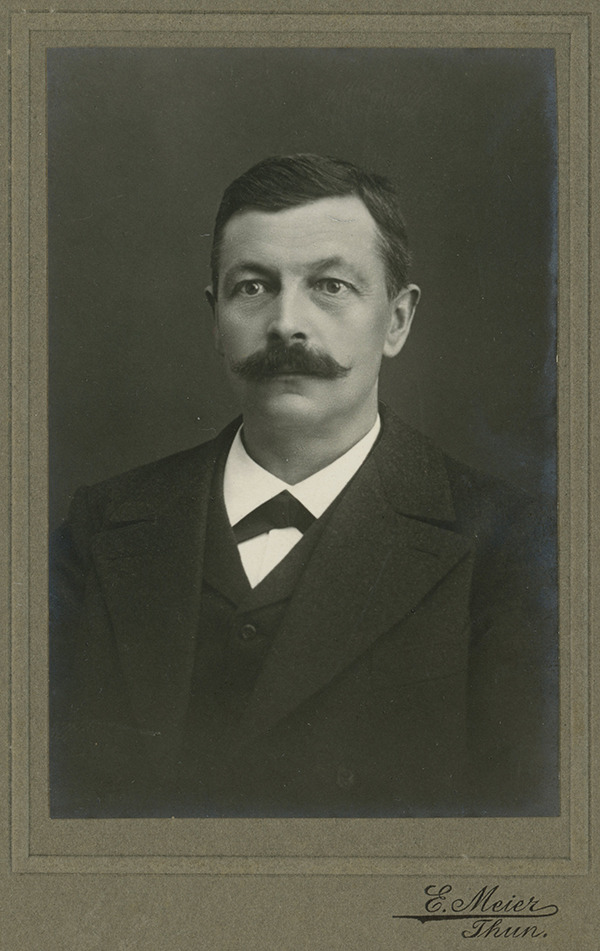
Karl Loder-Eyer (1871-1915), photo taken on an unknown date, probably around 1910.
Pottery made by Karl Loder-Eyer in CERAMICA CH
Andreas Heege, Andreas Kistler, 2022
The potter Karl Loder was born on 22nd March 1871 (Burgerrodel [register of citizens] BR Grossaffoltern 1, 209). His grandfather Bendicht Loder (1808–1874; BR Grossaffoltern 1, 209) was a municipal clerk in Steffisburg and a school teacher in Niederwichtrach, Wichtrach, Langnau, Affoltern, Hofwil, Röthenbach and Jaberg. Bendicht Loder had 12 children with his second wife, Anna Barbara Aeschlimann from Langnau (1825–after 1878) (see the family tree). Of their six sons, two became potters: Bendicht Loder-Walder (1855–1909; BR Grossaffoltern 1, 213) and Johann Loder (1844–1894; BR Grossaffoltern 2, 107). Johann Loder married a potter’s daughter, Anna Elisabeth Gfeller (1842–1871; BR Worb 2, 107; her father was Johannes Gfeller, 1816–1862, potter in Heimberg). Johann and Anna had three children: Karl Loder (1871–1915), (Karl) Johann Loder (1869–1894) and Maria Loder (1868–1869). After Anna died, Johann married Maria Elisabeth Moser (1836–1906), whose first husband called Liniger had also died. This second marriage was without issue.
In 1883, Johann Loder acquired the potter’s property at 206 Bernstrasse in Steffisburg (Grundbuch [land register] GB Steffisburg 50, 384–387). The deeds identify him as a potter in Heimberg, though no records could be found of him owning a property there, so he was probably leasing a premises. The property in Steffisburg included a residence with an integrated barn as well as two potters’ workshops which had been used by the brothers Künzi, Christian (1813–1851), Johannes (1818–1887) and Samuel (1820–1870), between 1834 and 1865. The sale included the colour mill and the “potters’ ware boards”. After the death of Johann Loder in 1894 and of (Karl) Johann Loder only three months later, the debt-ridden property (value 11,000 Swiss francs, debt 9153 Swiss francs) went to 23-year-old Karl Loder who received it from his stepmother in lieu of his future inheritance (GB Steffisburg 53, 644–647). On 1st March 1898, Karl Loder sold the property including its assets and liabilities to a gardener, who, that same year, sold it on to a farmer (GB Steffisburg 55, 200-204, 425). Pottery production on the property probably ceased after 1898.

The potters’ property at 167 Alte Bernstrasse in Steffisburg; date of photo unknown, probably after 1900.
Karl Loder could probably afford to let go of the workshop because on 5th September 1898, he had taken over the potters’ property at 167 Alte Bernstrasse in Steffisburg, again in lieu of a future inheritance (GB Steffisburg 55, 208–211). It had belonged to his father-in-law, potter Christian Eyer (1845–1898).

Karl had married Anna Elisabeth Eyer (2nd December 1872–29th April 1933) in 1898. The couple had no children.
We can only assume that Karl Loder had learnt his craft in his father’s workshop. There are no archival sources to confirm this assumption, nor are there any documents, or signed products, from his time at 206 Bernstrasse in Steffisburg (1894-1898).


The records of his activities begin with newspaper cuttings from 1899 (Täglicher Anzeiger für Thun und das Berner Oberland, 11th and 17th August; Thuner Wochenblatt 16th August). Charles, as he appears to have been calling himself at that stage, had participated in the I. Bernisch-Kantonale Industrie-, Gewerbe- und Landwirtschaftsausstellung (first industry, crafts and farming exhibition of the Canton of Bern) as part of a collective exhibition staged by the Industrial Association of Heimberg and had won a silver medal, as had his uncle, Bendicht Loder-Walder. On the same occasion, the Wanzenried Manufactory was awarded an honorary certificate and the Musée céramique of pottery trader L. Hahn won a gold medal.

- Bernisch-Kantonale Industrie-, Gewerbe- und Landwirtschaftsausstellung, Thun 1899, the Industrial Association of Heimberg’s exhibition stand.
The photograph of the stand that was printed in the exhibition guide shows that Fritz Frank-Mäder, Christian Frank-Jenny, Friedrich Hänni-Kratzer, Charles Loder-Eyer, Bendicht Loder-Walder, Jakob Reusser, Jakob Schenk, Gottfried Tschanz, Ernst Wittmeier and Eugen Rorschach (Bern) all worked in the “Thun majolica” style, which at the time was still very popular both with the Bernese public and with tourists. The potters mentioned were probably also the main suppliers to the Musée céramique.

- Bernisch-Kantonale Industrie-, Gewerbe- und Landwirtschaftsausstellung, Thun 1899, the Wanzenried Manufactory’s exhibition stand.
Visually, and perhaps also in terms of quality, the usually unmarked ceramics made by these potters were probably almost indistinguishable from the products made by the Wanzenried Manufactory, which also had a large stand at the exhibition in Thun.
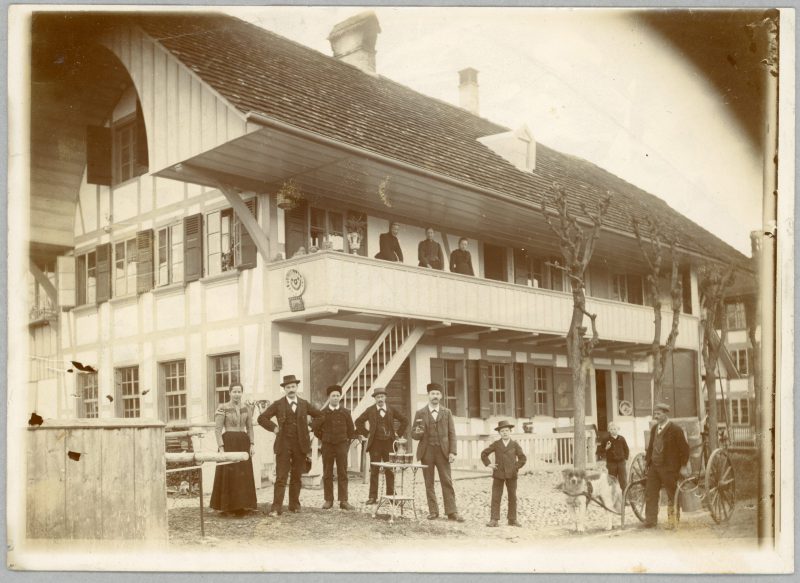
From left: Anna Elise Loder-Eyer, Karl Loder-Eyer and a number of unknown individuals in front of the Loder-Eyer potters’ workshop at 167 Bernstrasse in Steffisburg, in c. 1900 or shortly thereafter. The small boy wearing a hat is Emil Loder (1890-1971).
The year 1900 brought changes to the family. At the last Verdingkindergemeinde (a hiring fair where children from large families were “auctioned off” to live with and work mainly for farming families) in Steffisburg on 28th December 1900, Emil Loder, Karl Loder’s cousin (see the family tree), and his brothers Ernst Robert (1891–1969) and Walter (1882–1930) were “hired out” to the childless Karl Loder-Eyer (1871–1915) for an annual boarding wage of 65 Swiss francs. Becoming part of the family of his much older cousin had quite a considerable impact on Emil’s life. On 10th May 1906 he was given a contract for an apprenticeship with Karl Loder. His wages of 200 Swiss francs were to be paid by the poverty commission of the municipality of Heimberg (Gemeindearchiv Heimberg, Akten der Armenkommission 1906, 97 (30/8/1906).

Geschäftsblatt für den obern Teil des Kantons Bern 20th December 1902 3rd Edition.
In a report on the 1902 Christmas Exhibition at the Museum of Applied Arts in Bern, Museum Director Oscar Blom reviewed Karl Loder-Eyer’s work very favourably (Geschäftsblatt für den oberen Teil des Kantons Bern 1902, No. 49, 20/12/1902). The potters Loder-Walder and Tschanz were also mentioned.


In December 1902, Karl Loder-Eyer also participated in the second competition run by the Museum of Applied Arts in Bern for objects made of fired clay (majolica). While the Wanzenried Manufactory still won first prize in some of the categories, Karl Loder’s products appear to have been comparable in terms of quality. Bendicht Loder-Walter was awarded third prize in one of the categories and the Musée Céramique under L. Hahn received an honourable mention (Geschäftsblatt für den oberen Teil des Kantons Bern 50, No. 28, 1/4/1903). On 11th April 1903, the Tägliche Anzeiger für Thun und das Berner Oberland newspaper (Volume 27, No. 86) congratulated the prize winners and in this context mentioned Karl Loder as a “promoter of indigenous industry”.


Visitenkarte von Karl Loder-Eyer, nach 1903.
Karl Loder appears to have been very proud of the awards he won in Thun and Bern, as they prompted him to print new business cards that included his company mark (a ligature logo CHL – Charles Loder; the mark was not, however, registered in the Swiss Register of Businesses). As well as the prizes won in Thun and Bern, the business card also points to an award ceremony in Paris. This can only refer to the Paris World Exposition of 1900, where L. Hahn’s Musée Céramique won a bronze medal for its Thun majolica (La Tribune de Geneve, 1/9/1900). Is it possible that Karl Loder was one of Hahn’s main suppliers and felt that the medal should really be his?
On 30th December 1905, Karl Loder-Eyer and Marie Mürner, née Gfeller (as heiress to her late husband, the potter Samuel Mürner) dissolved the “Hülfs- und Freundschafts-Verein” (Friendly Society) of Heimberg potters, which had been founded on 26th June 1877. They were the last surviving members of the society and Mrs. Mürner had only recently closed her pottery business. The final accounts filed by Karl Loder-Eyer show that in the end the society only owned one cart of “Glätte” [=Lead(II) oxide , PbO] from the company Lutz & Schrämli” worth 2380 Swiss francs. It was milled by Mrs. Wanzenried at a cost of 598.50 francs, and then handed over to Karl Loder-Eyer (final accounts in the Kunstkeramik Luzern company archive in the State Archive of Lucerne).

Excerpt from the Täglicher Anzeiger für Thun und das Berner Oberland 19/12/1905.

Oscar Blom, Der BUND 21/12/1905, excerpt.
The 1905 Christmas Exhibition curated by the Museum of Applied Arts was positively reviewed by the press (Täglicher Anzeiger für Thun und das Berner Oberland 3/12/1905, 19/12/1905, 30/12/1905; Der BUND 21/12/1905). Special mention was made of the “grand pyramid of Thun majolica exhibited by Gottfried Beutter in Thun [successor to L. Hahn at the Musée Céramique], Karl Loder-Eyer in Steffisburg and B. Loder-Walder, master potter in Heimberg”. Oscar Blom again praised Karl Loder-Eyer’s products in a review in the BUND newspaper.
The 1902 competition and the Christmas exhibitions at the Museum of Applied Arts were some of the events launched by its director, Oscar Blom, to promote and improve the artisanship and pottery production throughout the Canton of Bern. His efforts to improve the potters’ skills eventually led to the setting up of a state-sponsored pottery school in Steffisburg in August 1906 (Verwaltungsbericht der Direktion des Inneren des Kantons Bern 1906, 204. See also Messerli Bolliger 1991). Karl Loder was one of the members of the supervisory board (Blom 1908). Ferdinand Huttenlocher’s (1856–1925) modelling class and Paul Wyss’s (1875–1952) decorating class were attended by 24 students. They included Karl Loder-Eyer, Emil Loder, as well as their cousins Friedrich Loder (1890–?) and Rosa Ida Loder (1889–1912).

Huttenlocher and Wyss also taught pottery classes at the Handwerker- und Kunstgewerbeschule (a school for tradesmen, today the School of Applied Sciences) in Bern, which had been set up in 1905. Karl Loder-Eyer also attended the classes and was awarded state scholarships in 1905 and 1906 (possibly at the behest of Oscar Blom?). Like his father, Bendicht Loder-Walder, who worked for the arts and crafts designer Nora Gross, Karl Loder-Eyer appears to have been one of the more open-minded potters in the Heimburg-Steffisburg region and was a firm believer in education.
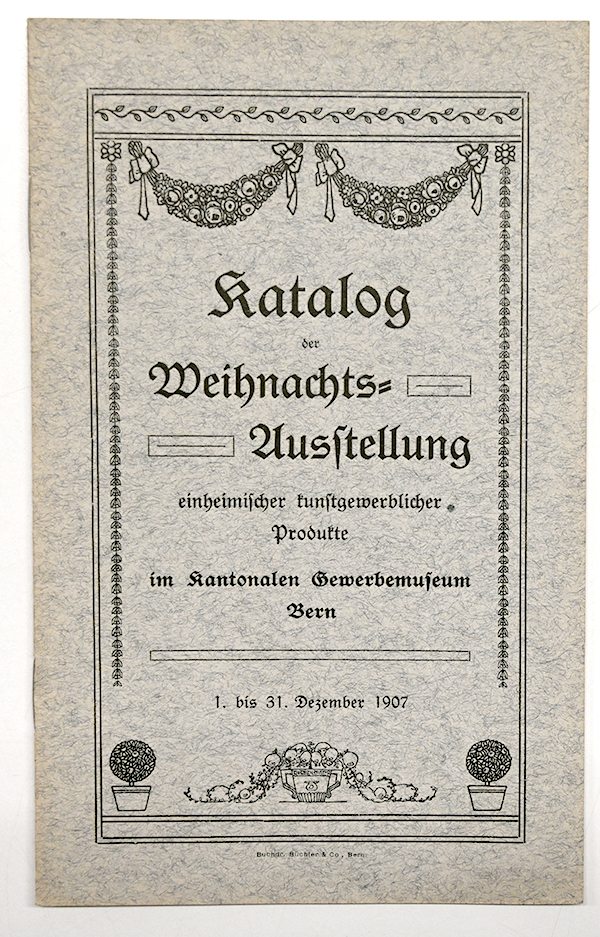
At the Christmas Exhibition staged by the Museum of Applied Arts in Bern, Karl Loder-Eyer, Steffisburg, again exhibited a majolica collection. Other exhibitors included Bendicht Loder-Walder, Heimberg (majolica collection) and the Steffisburg Potters’ Collective (majolica collection).
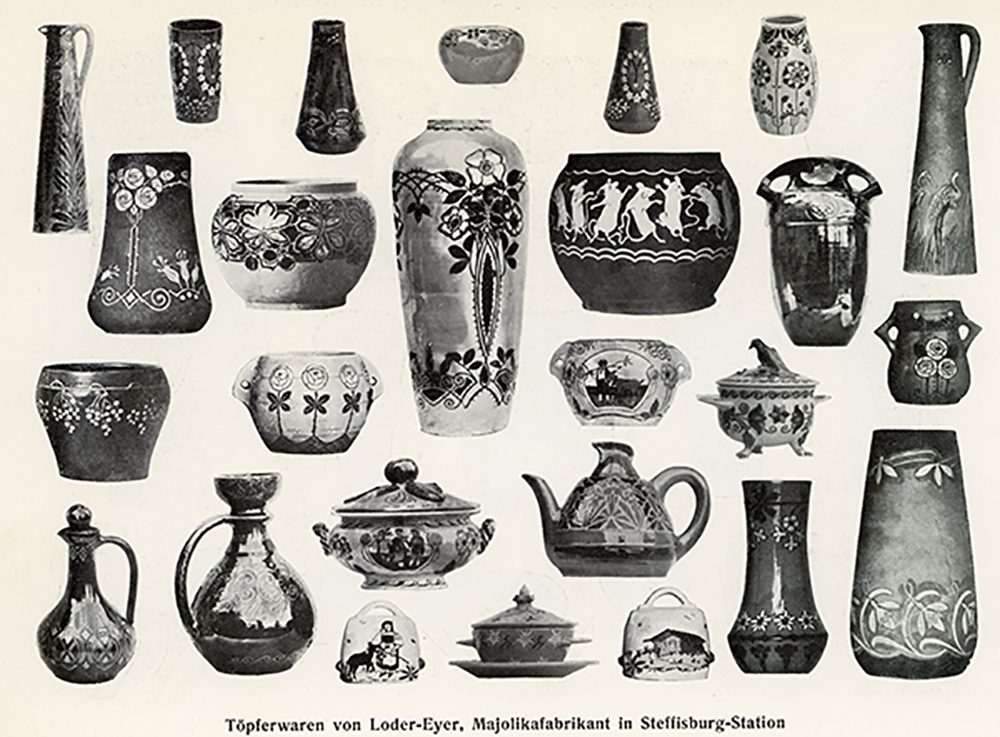
Pottery produced by Karl Loder-Eyer, published in 1908.
This may have been the reason why Oscar Blom published a selection of Karl Loder-Eyer’s current products in the 1908 annual report. By reproducing the range of wares by Loder-Eyer, the Wanzenried Manufactory and Bendicht Loder-Walder in the report, Blom hoped that other potters would be inspired to emulate them. This is the first firmly dated record of what Loder-Eyer’s products looked like. In terms of both their decorative motifs and their shapes, they were relatively far removed from the historicist Thun majolica, which Oscar Blom, and probably the pottery instructors, considered passé (Blom 1908). The contemporary designs bore stylised floral Art Nouveau motifs like the ones that arts and crafts instructor Paul Wyss was teaching the potters and pottery paintresses and painters in Bern and Steffisburg. This explains why the ceramics exhibited by Karl Loder at the 1906 Christmas Exhibition curated by the Museum of Applied Arts was presented as a “collection of new Heimberg majolica wares” (Intelligenzblatt für die Stadt Bern, 15/12/1906; see also Täglicher Anzeiger für Thun und das Berner Oberland, 19th December 1906).
In 1911, Karl Loder-Eyer registered his workshop/company in the Swiss Official Gazette of Commerce (SOGC 29, 1911, p. 1650). The reasons remain unknown, and this was the only time he ever did this. On 22nd December 1911, he also had a will drawn up. With his wife’s consent, his cousins Emil Loder (1890-1971), Ernst Robert Loder (1891–1969) and Walter Loder (1882–1930) were appointed as heirs to the company. The fact that the couple had remained childless was cited as grounds for this decision.
In preparation for the 1914 National Exhibition in Bern, a “Christmas and Art Industry Exhibition” was staged at the Museum of Applied Arts in Bern in 1910/11, where the exhibitors had to integrate their ceramic objects into a overall interior design context. As we know from a review of the exhibition in the BUND newspaper (18/1/1911), the space for Karl Loder’s exhibits was designed by the Bern architect Otto Ingold (1883–1943). The review read: “Exhibitor: Karl Loder-Eyer, potter, Steffisburg, majolica and ceramic wares with colourful frit, some to his own designs, others to the designs of the architect Otto Ingold and the School of Ceramics in Steffisburg. The floral patterns stand out the most. The impact of the interior design exhibition is noticeable in the well-proportioned shapes of the individual pieces, which are immediately reminiscent of and derived from a particular use (e.g. a decorative piece for a niche etc.), and the rather austere decorative designs, which are in stark contrast to the naturalistic ornaments of previous years.”
In Bern, Ingold was a well-respected member of the Reformarchitektur (Arts and Crafts) movement and was known particularly for his 1908 design of Cuno Amiet’s artist’s house at Oschwand and the Volkshaus in Bern, which opened its doors in 1914. In 1913 he was involved in the founding of the Schweizerischer Werkbund. While in neighbouring countries – notably in Germany – potters were already making objects to the designs of well-known Arts and Crafts artists like Henry van Velde (1863–1957), Peter Behrens (1868–1940), Albin Müller (1871–1941) and others, the collaboration between Ingold and Loder-Eyer was a first for Bern and garnered praise from the journal Die Schweizerische Baukunst: “The fact that the individual pieces in an exhibition of this kind can display their own charm does not have to be made clear to the visitor. Some of the vases are made to the manufacturer’s designs, but most are based on designs by the architect Otto Ingold and the School of Ceramics in Steffisburg.” (cited after Messerli 2009, 62-63).

Pottery exhibition in 1913, Basler Volksblatt no. 208, 7th September 1913, (Bern State Archive BB 1.9.7).
1913 Ceramics by Karl Loder-Eyer and Emil Lengacher (owner of the former Wanzenried Manufactory) were shown alongside the works of the pottery class from the Museum of Applied Arts in Bern in an exhibition curated by the Museum of Applied Arts in Basel and were very favourably reviewed. Vases by Adolf Gerber and Johann Röthlisberger from Langnau, on the other hand, were not too favourably received. In the exhibition, the Swiss works had to compete with ceramics by Max Läuger, the Karlsruhe Majolica Manufactory, the Berlin and Copenhagen porcelain manufactory and pottery by Wedgwood.

Geschäftsblatt für den oberen Teil des Kantons Bern, Volume 61, No. 49, 20th June 1914
Various newspapers and print media reported on the 1914 National Exhibition in Bern. In June of that year, we are told that Karl Loder-Eyer, the Loder Brothers from Heimberg, Friedrich Hänni-Kratzer from Heimberg, Miss Anna Müller from Grosshöchstetten, the Reusser workshop in Heimberg and Gottfried Moser from Wichtrach were all represented at the exhibition. Another exhibitor was Emil Lengacher, who by that time had taken over the Wanzenried Manufactory.

Thanks to the photos in an article by Jacob Hermanns (who taught pottery making at the School of Ceramics in Bern from 1907 and was a member of the bazaar committee for the National Exhibition of the Swiss Heritage Society) in the Schweizer Illustrierte Zeitung in 1914, we have an impression at least of the production lines that Karl Loder-Eyer put on display in Bern. He also exhibited his ceramics in the “Heimkunst-Werkstätten [indigenous art workshops], sub-group 49A II” in the “Dörfli” [village] at the National Exhibition (Heimatschutz 9, 1914, 156), and in group 23 “ceramics and glassware” in a special hall in the Neufeld area (Kiefer 1914, expert report). The Heimkunstwerkstätten [indigenous art workshops] also offered presentations and craft demonstrations. Robert Loder (1891-1969) manned the potter’s wheel there (according to historical records from the Emil Loder company archive in the State Archive of Lucerne).

He was also one of the suppliers to the bazaar, also in the “Dörfli”, run by the Swiss Heritage Society (Conradin 1914, 99). All the wares and souvenirs sold there had to be authorised in advance by the bazaar committee or had to have been entered in a “souvenir competition” in 1913 (Heimatschutz 8, 1913, Volume 6, 95; winners: Heimatschutz 8, 1913, Volume 11, 122-123).

A tour of the bazaar by a journalist from the NZZ newspaper (21/6/1914) specifically mentioned “jolly groups of dancing peasants” (ceramic figurines?) from the Loder-Eyer workshop, none of whom, to our knowledge, have survived.




We do know, however, of a private collection that contains two signed figures with a reference to the homeware store “Kaiser & Cie” in Bern. It too was among the approved suppliers to the Swiss Heritage bazaar and had submitted numerous objects to the “souvenir competition” that had been held prior to the National Exhibition. Surprisingly, the 1913 list of awards does not identify Karl Loder- Eyer as the artist who made the figures, but rather the ceramicist Cäsar Adolf Schmalz from Heimberg (“12 figures of peasant dancers and musicians”). A monograph on Schmalz’s work also lists the two figures (Marti/Straubhaar 2017, 127). Does this mean that Schmalz worked for Karl Loder-Eyer and that is why the figures bear his signature? More in-depth research on Cäsar Adolf Schmalz is probably required to answer this question.
A review of the exhibition in the NZZ (reprinted in the Oberländer Tagblatt on 30/10/1914) emphasised the wealth of decoration on Loder’s ceramics while at the same time criticising the patterns as often random and not sufficiently well adapted to the shape of the objects. The BUND newspaper (10/9/1914) classified Karl Loder-Eyer’s ceramics, together with those made by the Loder Brothers and the Wanzenried Manufactory (under E. Lengacher), as Thun majolica and rated them as “most inventive and exquisite”.
The final expert report on the exhibition highlighted the large range, the wealth of decorative patterns and the high technical skill involved in the making of Karl Loder-Eyer’s objects. “As well as slip-trailing, almost all ceramic techniques have been applied to a high standard while the indigenous style has not been neglected” (Kiefer 1914).
Nine numbered and three unnumbered plates of photographs give an impression of the ceramic objects produced by Karl Loder-Eyer. They are part of the archive of Kunstkeramik Luzern (housed today in the State Archive of Lucerne), where Emil Loder probably deposited them at some unknown time. The photographs were taken shortly after 1900 but probably on separate occasions. Shape number 134, however, clearly bears the date 1914 and some of the objects (shapes no. 126, 151, 201 and 213) correspond to the ones that were exhibited at the National Exhibition in Bern. Classic Thun majolica and “Chrutmuster” herbal patterns can be seen side by side with designs reminiscent of Nora Gross’s style or souvenirs with Swiss landscapes and classic views of tourist hot spots (Thun, Château Chillon, Lake Geneva); people engaged in winter sports on light-blue glazes contrast with designs by Paul Wyss and pottery in the “Alt-Langnau” style and Art Nouveau designs which Karl Loder had been producing from as early as 1907/1908 (see above). The Thun Castle Foundation has in its collection an example from the light-blue series which is inscribed with the date 1914 and the acronym S.L.A.B. (Swiss National Exhibition Bern). The series itself was probably earlier, however, as a photograph of shape 35 was first published in 1908.



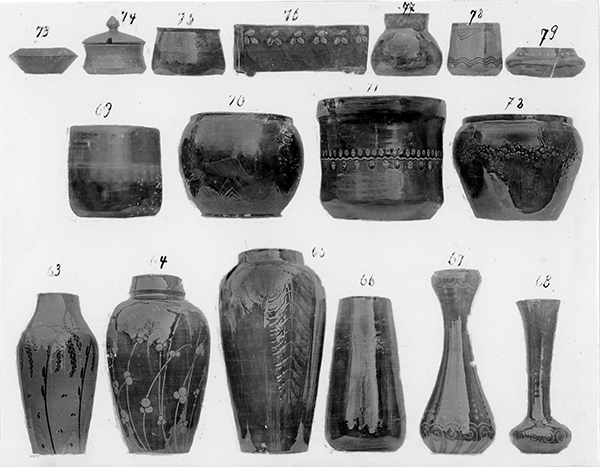







The photograph above has nothing written on it and the pottery can only be tentatively attributed to Karl Loder-Eyer.

Oberländer Tagblatt 10/11/1914. Note: The announcement neglects to mention the silver medal won by Johannes Röthlisberger from Langnau!
The National Exhibition yielded gold medals both for Karl Loder-Eyer and for Emil Lengacher. The Loder Brothers and master potter Reusser from Heimberg each won a bronze medal.
Museum collections generally contain only a small number of objects made by Karl Loder-Eyer and his workshop, and his work deserves more in-depth study. The Thun Castle Foundation houses a somewhat larger collection (inventoried in 2023-2025).
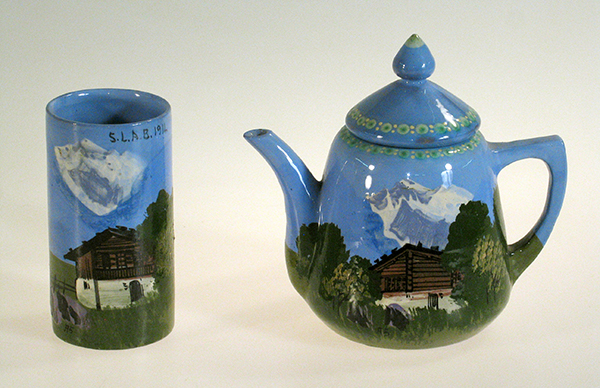
Swiss souvenirs dated 1914 (Thun Castle Foundation).

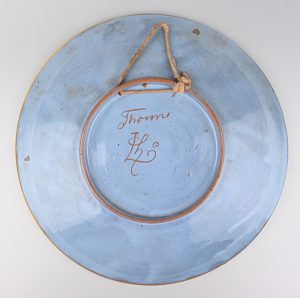
Karl (Charles) Loder-Eyer, plate from the winter sports series, signed “CHL” and “Thoune”. Private collection.




Karl (Charles) Loder-Eyer, two plates from a series depicting women wearing aprons with unusually large bows, signed “Thun”. Thun Castle Foundation.



A series of kitchen storage jars designed by Karl Loder-Eyer, Thun Castle Foundation.


Two plates from 1913 and 1914 in the collection of the Regional Heritage Museum in Trubschachen are impressive examples of the outstanding quality that Karl Loder-Eyer was able to produce.


Oberländer Tagblatt 15th May 1915
Karl Loder-Eyer did not get to enjoy his success for very long. On 11th May 1915, he suffered a stroke and died at just 44 years of age (obituary in the BUND newspaper dated 14th May 1915; see also Geschäftsblatt für den oberen Teil des Kantons Bern, Volume 62, No. 58, 15th May 1915).
According to his last will and testament dated 1911, Karl’s cousin Emil Loder (listed as a ceramicist or painter in the records of the land register) and Emil’s brothers, (Ernst) Robert Loder (potter at the time) and Walter Loder (labourer at the time), were the principal heirs. The will was read on 20th May 1915 and was declared valid by the Municipal Council of Steffisburg on 20th November 1915. The assets of each of the three brothers were entered in the land register (GB Thun Bel. I 2880, 288). However, the heirs had already come to an arrangement with Karl’s widow Anna Loder-Eyer on 12th November 1915, according to which she would buy them out of the entire inheritance, and they would then divide the resulting assets amongst themselves as part of the division of the estate (GB ThunBel. I 2880, 2881). On 28th December 1915, the Swiss Official Gazette of Commerce announced the closing of the company “Karl Loder-Eyer Art Pottery” (SOGC 33, 1915, 1763).
On 1st May 1917, Karl’s widow Anna Loder-Eyer sold the workshop with all its assets and liabilities to a cooperative which had already been set up on 13th September 1915 under the name “Steffisburg Art Pottery, formerly Karl Loder-Eyer”; it would later become DESA in Steffisburg (GB Thun Bel. I, 4118). Before the sale, the cooperative had leased the enterprise (GB Thun Bel. I, 4118). Adolf Schweizer from Steffisburg (1893–1967), who had completed an apprenticeship with the Wanzenried Manufactory and had attended pottery classes at the School of Ceramics in Bern from 1911 (Messerli 2009, Appendix List of Students), was appointed technical manager and managing director (obituary: Thuner Tagblatt 91, 1967, Issue 288).
Translation Sandy Haemmerle
References:
Blom 1908
Oscar Blom, Die Förderung der Majolika-Industrie in Heimberg-Steffisburg-Thun durch das kantonale Gewerbe-Museum in Bern, in: Jahresbericht pro 1907 des kantonalen Gewerbemuseums Bern, 1908, 1-9.
Kiefer 1914
Georges Kiefer, 23: Gruppe: keramische und Glaswaren. Schweizerische Landesausstellung in Bern 1914, Fachberichte Band VI.
Marti/Straubhaar 2017
Erich Marti/Beat Straubhaar, C.A. Schmalz 1887-1966. Leben und Werk mit Pinsel, Stift und Lehm, Heimberg 2017.
Messerli Bolliger 1991
Barbara E. Messerli Bolliger, Der dekorative Entwurf in der Schweizer Keramik im 19. Jahrhundert, zwei Beispiele: Das Töpfereigebiet Heimberg-Steffisburg-Thun und die Tonwarenfabrik Ziegler in Schaffhausen, in: Keramik-Freunde der Schweiz, Mitteilungsblatt 106, 1991, 5-100.
Messerli 2009
Christoph Messerli, Von der Souvenir- zur Studiokeramik. Die Berner Keramik im 19. und 20. Jahrhundert. Lizentiatsarbeit, Institut für Kunstgeschichte des Universität Bern, Bern 2009.
Wyss 1966
Robert L. Wyss, Berner Bauernkeramik (Berner Heimatbücher 100-103), Bern 1966.

